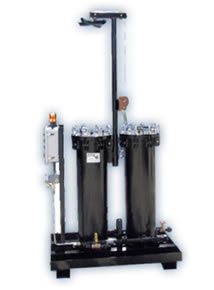Model 502 Dual-Housing Quench Filtration System

Issue: A major manufacturer of fasteners contacted JDI, Inc. to improve the quality of their quench oil through filtration. They had belt furnaces for the heat treatment of fasteners and were not doing any filtration at all. Their quenching oil was FENSO 150 from ESSO.
The goal was to remove contamination such as carbon, flash, oxidation, and fines from the quench oil to achieve proper quench speeds and cooling rates. Additionally, they wanted to minimize issues of moisture, bottom solids, and TAN.
Solution: They purchased a Model 502 dual-housing quench filtration system. During the initial start-up, there was very heavy loading throughout the filter media accompanied by a rapid rise of the pressure. It was an indication that there may have some issues with the hydrodynamics of the system.
JDI, Inc. staff first performed a thorough inspection and dissection of the elements. The results showed uniform, heavy loading of contamination throughout the media.
We also examined the external piping and found that the unit was piped so that the suction piping pulled quench fluid from the very bottom of the quench tank. It is possible that solids from the tank bottom pre-loaded the filters resulting in a short element life. To remedy this situation, the suction piping was relocated to half way up the quench bath. Filter life has improved since then.
The quench oil performance data is the gold standard which must be measured to assess filter life. Typically, we want to maintain quench speed, cooling rates, and TAN within spec by removing just enough contamination in the quench oil to maintain these metrics. The goal is not to remove all of the contamination in the quench oil, but only enough contamination to keep the oil within specifications and prevent staining of parts from the dirty oil.
By providing an engineered approach to quench oil filtration, JDI, Inc. has helped our customer reduce operating costs and improve production quality.

